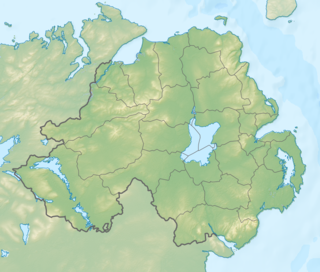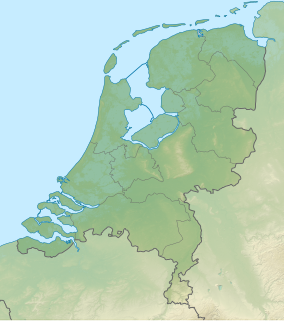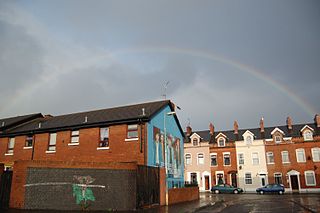The South Armagh Republican Action Force sometimes called simply the Republican Action Force was an Irish republican paramilitary group that was active from September 1975 to April 1977 during the Troubles in Northern Ireland. Its area of activity was mainly the southern part of County Armagh. According to writers such as Ed Moloney and Richard English, it was a covername used by some members of the Provisional IRA South Armagh Brigade. The journalist Jack Holland, alleged that members of the Irish National Liberation Army (INLA) were also involved in the group. During the same time that the South Armagh Republican Action Force was active the INLA carried out at least one sectarian attack that killed Protestant civilians using the covername "Armagh People's Republican Army". According to Malcolm Sutton's database at CAIN, the South Armagh Republican Action Force was responsible for 24 deaths during the conflict, all of whom were classified as civilians.

The Battle of Lenadoon was a series of gun fights over six days from the 9–14 July 1972 between the Provisional IRA and the British Army, having started on Thursday, 9 July 1972 in and around the Lenadoon Avenue area and spreading to other places in Belfast. Loyalist paramilitaries and the Official Irish Republican Army were involved in some of the incidents. 28 people in total were killed in Belfast according to the CAIN: Sutton Index of Deaths. The violence ended a two-week truce between the forces of the British Government and the IRA.

The Provisional IRA carried out two separate attacks on the same day on 1 May 1988 against British military personnel in the Netherlands which resulted in the deaths of three RAF members and another three being injured. It was the worst attack suffered by the British security forces during The Troubles from 1969 to 1998 on mainland Europe.
On 5 April 1975 Irish republican paramilitary members killed a UDA volunteer and four Protestant civilians in a gun and bomb attack at the Mountainview Tavern on the Shankill Road - the heart of loyalist Belfast. The attack was claimed by the Republican Action Force believed to be a covername used by Provisional IRA (IRA) volunteers. Earlier in the day, two Catholic civilians were killed in a bomb attack in a Belfast pub carried out by the Protestant Action Force a name used by the Ulster Volunteer Force to claim some attacks. An elderly Catholic man was shot later the same night by loyalists bringing the death toll to eight for the day.

On 9 April 1990 the Provisional IRA (IRA) detonated a massive IED roadside bomb under an Ulster Defence Regiment (UDR) mobile patrol which killed four members of the UDR. It was the worst attack against the UDR since seven years previously when, in July 1983, four soldiers of the same regiment were killed in a similar attack near Ballygawley. It was also one of the worst attacks against the security forces in County Down since the Warrenpoint Ambush of August 1979 when 18 British soldiers were killed and six injured.

On 18 February 1991 the Provisional IRA (PIRA) exploded two bombs at London mainline stations, one at Victoria station and the other at Paddington station, killing one person and injuring 38 other people all at Victoria station. It was the IRA's second major attack in London in February 1991 after the Downing Street mortar attack eleven days earlier which was an attempt to wipe out the British War cabinet and the British prime minister John Major. It was also the first IRA attack against a civilian target in England since the 1983 Harrods bombing, marking a strategic change in their bombing campaign in England.
On 2 October 1975, the loyalist paramilitary group the Ulster Volunteer Force (UVF) carried out a wave of shootings and bombings across Northern Ireland. Six of the attacks left 12 people dead and around 45 people injured. There was also an attack in a small village in County Down called Killyleagh. There were five attacks in and around Belfast which left people dead. A bomb which exploded in Coleraine left four UVF Volunteers dead. There were also several other smaller bombs planted around Northern Ireland but other than causing damage they didn't kill or injure anyone.
On 23 October 1971 undercover soldiers from the British Army shot dead three unarmed Catholic civilians in disputed circumstances in Newry.
The Belturbet bombing occurred on 28 December 1972 when a car bomb planted by Loyalist paramilitaries exploded in the main street in the border town of Belturbet in County Cavan in the Republic of Ireland. The bomb killed two teenagers Geraldine O'Reilly (15) and Patrick Stanely (16). Nobody claimed responsibility for the bombing but security services believe the Ulster Volunteer Force (UVF) carried out the attack. The attack happened just a few weeks after two people were killed and 127 injured when two car bombs exploded in the centre of Dublin, Republic of Ireland on 1 December 1972. On the same day as the Belturbet bombing, two other bombs exploded in border counties, the first in Clones, County Monaghan which injured two people and the second in Pettigo in County Donegal which caused no deaths or injuries. The three bombs all exploded within 30 minutes of each other.

In the late hours of 3 February and the early hours of 4 February 1973, six men, all of whom were Catholics, were shot and killed in the New Lodge area of north Belfast, four of them were shot dead at the junction at Edlingham Street by British Army snipers, the other two men were shot dead by the Ulster Defence Association (UDA). Irish Nationalists and Republicans believe that collusion took place between the British security forces and Loyalist paramilitaries in the shootings. The six men who were killed became known as "The New Lodge Six".
The 1975 Conway's Bar attack was a failed gun and bomb attack by the Loyalist Ulster Volunteer Force (UVF) paramilitary group. On 13 March 1975 a unit from the UVF's Belfast Brigade attempted to bomb the Catholic-owned Peter Conway's bar on the Shore Road in Greencastle, Belfast. The bomb exploded prematurely, killing a Catholic civilian woman and one of the UVF bombers.

The Strand Bar Bombing was a gun and bomb attack carried out by the Loyalist Paramilitary organisation Ulster Volunteer Force (UVF) in Belfast in 1975. The blast destroyed most of the building and killed six civilians and injured about 50 more.
On 12 September 1994 the Ulster Volunteer Force (UVF) planted a 1.5 kg bomb on the Belfast–Dublin train. It partially exploded as the train neared Dublin Connolly railway station, injuring two people.
The following is a timeline of Northern Irish conflict actions which took place in the Republic of Ireland between 1969 and 1998. It includes Ulster Volunteer Force bombings such as the Dublin and Monaghan bombings in May 1974, and other Loyalist bombings carried out in the 1970s, 80s & 90s, the last of which was in 1997. These attacks killed dozens of people and injured hundreds more. Also actions carried out by Irish Republicans including bombings, prison escapes, kidnappings, and gun battles between the Gardaí (police) and the Irish Defence Forces against Republican gunmen from the Irish National Liberation Army, the Provisional Irish Republican Army, and a socialist-revolutionary group, Saor Éire. These attacks killed a number of civilians, police, soldiers, and Republican paramilitaries.

The 1991 Craigavon killings took place on the 14 November 1991 when the Mid-Ulster Brigade of the Ulster Volunteer Force (UVF) shot dead three civilians at the Carbet Road-Carn Road junction near Craigavon, County Armagh, Northern Ireland, on their way home from work at a forklift factory just outside Lurgan.
The Irish National Liberation Army Belfast Brigade was the main brigade area of the Irish National Liberation Army. The other Brigade areas were in Derry and Armagh with smaller units in Newry, east and west Tyrone and south Fermanagh.
Paul Marlowe was a Volunteer in the Provisional IRA's Belfast Brigade. He held the rank of Training Officer (T/O) when he and two other experienced Volunteers, Frank Fitzsimons and Joey Surgenor, were killed when a bomb they were planting exploded prematurely at Belfast gasworks in October 1976. Marlowe was 31 and had a wife and three children when he died.

The Top of the Hill bar shooting was a mass shooting incident that took place during the height of the Northern Ireland Troubles that occurred on 20 December 1972 at the Top of the Hill bar in a small Catholic enclave of the majority Protestant Waterside area of Derry, in which five civilians were shot dead by Loyalist paramilitaries from a unit of the Ulster Freedom Fighters (UFF) which is a part of the Ulster Defence Association (UDA). The shooting is also known locally as "Annie's Bar massacre".
This is a timeline of actions by the Official Irish Republican Army, an Irish republican & Marxist-Leninist paramilitary group. Most of these actions took place as part of a Guerrilla campaign against the British Army & Royal Ulster Constabulary and internal Irish Republican feuds with the Provisional IRA & Irish National Liberation Army from the early 1970s - to the mid 1970s during the most violent phase of "the Troubles" in Northern Ireland.






